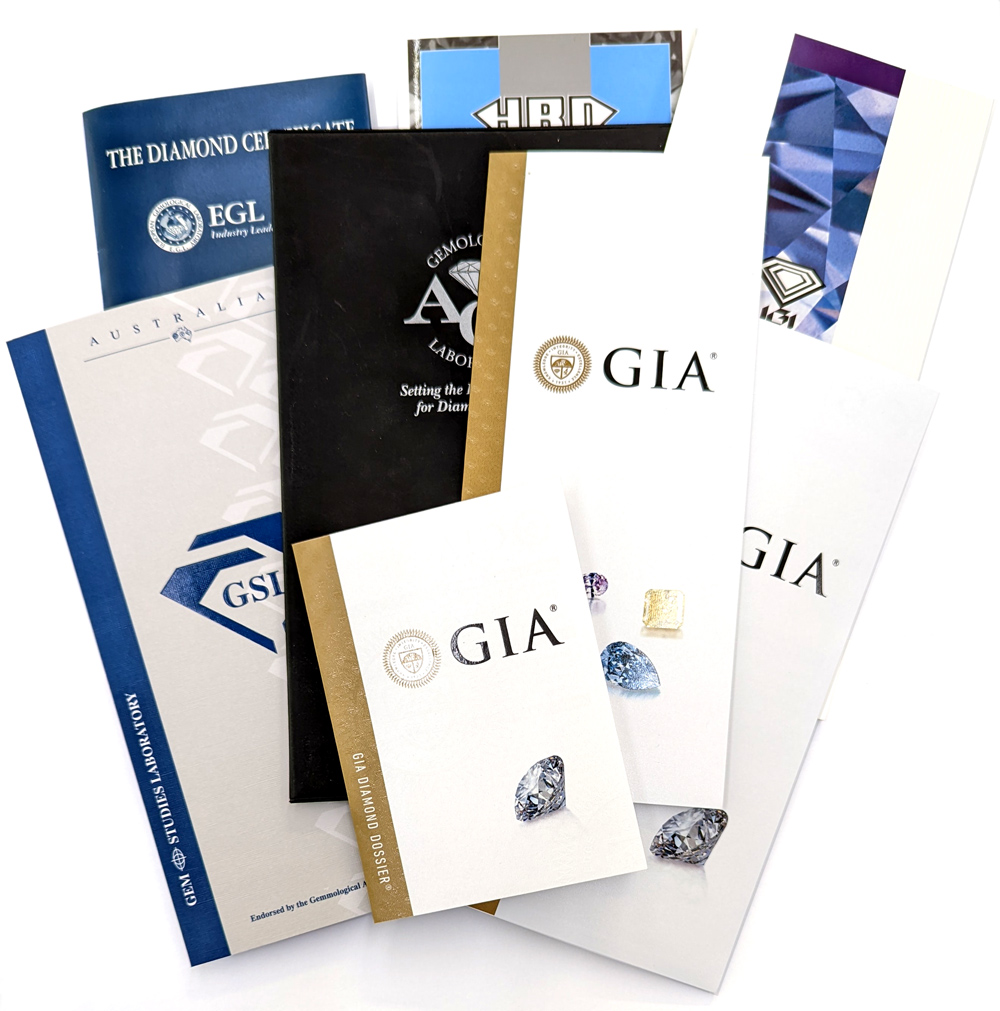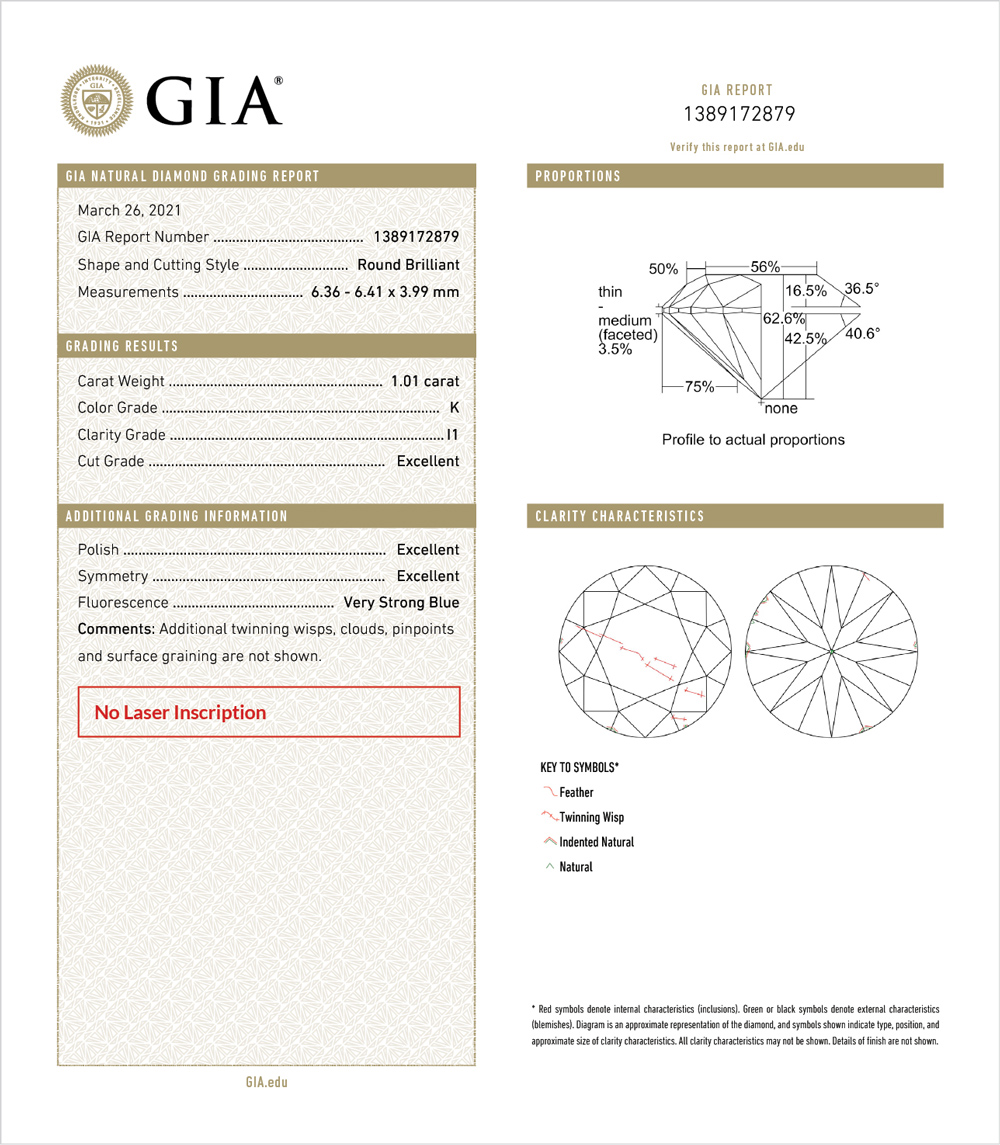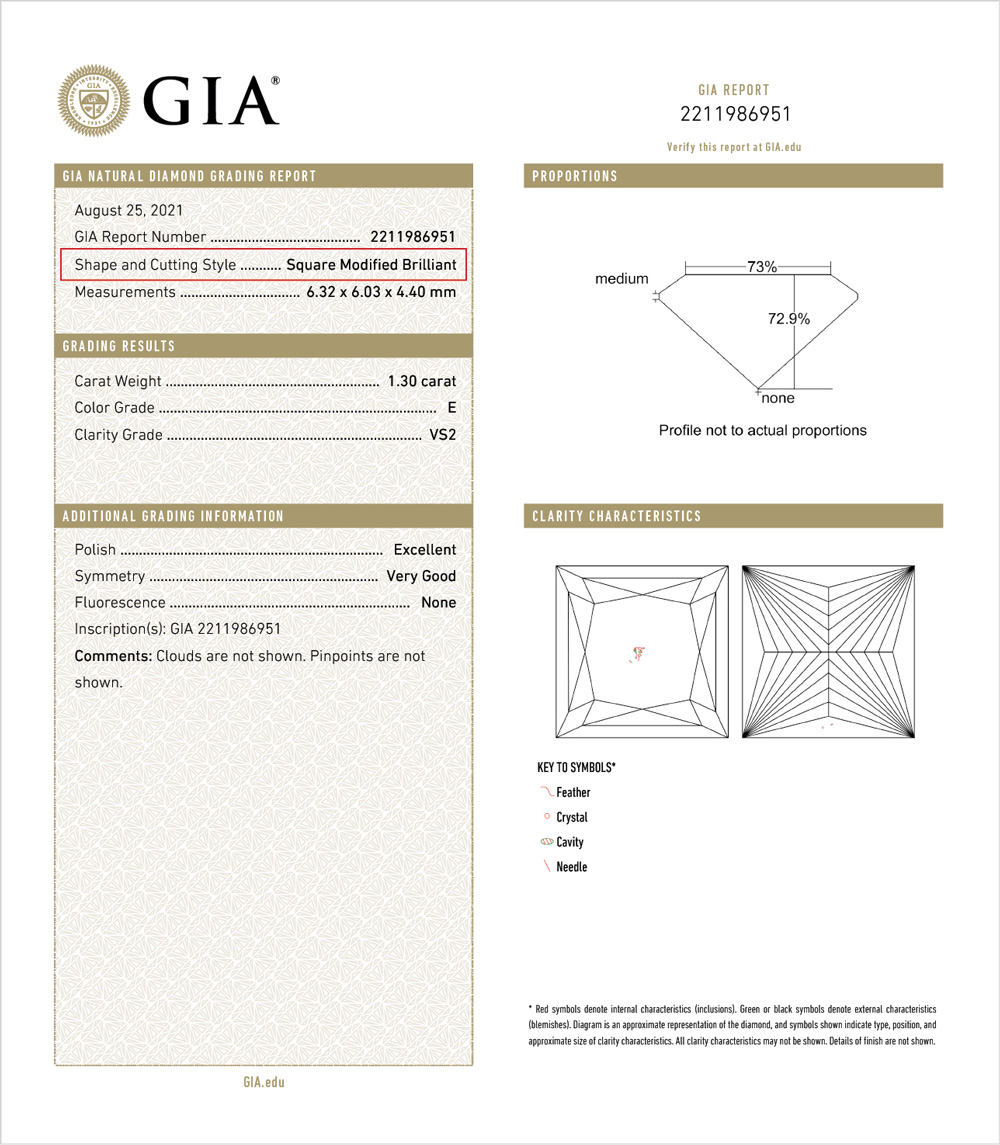Learn: Diamond Grading > GIA & Grading Labs
Introduction
International grading standards
Background
Study of GIA XXX top cut D-F
Report Shopping
How can I be sure the cert is for the same diamond?
Different types of GIA grading reports
GIA cut type naming
Diamond Grading
Myths & Facts
1. GIA is the best diamond grading lab:
True.
2. GIA protects consumers:
Garry Holloway disagrees. GIA could do a lot more
3. GIA can not be bribed to improve grades:
False, it has happened
4. A grading report guarantees I have a real diamond:
False, old reports get recirculated with matching lower grade or synthetic diamonds
5. A laser inscription ensures I have the right diamond:
False, see above

Read on for all the answers
In this section, you will learn why we focus so much on the Gemological Association of America or GIA.
Once upon a time, the only diamonds that came with a grading report from a laboratory were ‘investment diamonds’. A trend that started in the late 1970’s when D Flawless diamonds were selling for twice what they cost today, 50 years later! (Please don’t invest in colourless diamonds).

Diamond grading is done in a twilight zone. That may be why cut quality comes last?
Background
Since the USA consumes more than half the world’s diamonds it was natural that the leading grading outfit is the Gemological Institute of America or GIA, but that also has something to do with the cut grade (took GIA 5 more years than Garry Holloway with HCA). GIA is also the only not-for-profit large diamond grading lab, so not paying tax gives them an advantage. That amazing profit is a real benefit because we need the research to keep ahead of the cheats who would otherwise rip consumers off with synthetic gems and treated diamonds.
GIA was very ably led by Bill Boyajian from 1986 to 2006 and during that period virtually wiped the floor with the world’s other labs, which were mostly seen as privately owned and therefore open to bribery. Sadly for Bill, the GIA is the only lab ever caught falsifying grades. Bill resigned over the incident that was bought to light in late 2005.
The sale of unseen diamonds business to business and internationally relies on the diamond grading reports consistency. The consistency is in fact more important than the grading accuracy, and in spite of dealers haggling over miss graded diamonds, by and large, GIA runs a tight ship. Given they have eleven labs, mostly in Asia, and achieving consistency is a huge challenge. Labs are currently operated in Antwerp, Bangkok, Calrsbad, Gabrone, Hong Kong, Johannesburg, Mumbai, New York, Ramat Gan, Surat, and Tokyo.
There are other big grading labs including the International Gemological Institute (IGI), in several locations, HRD in Belgium, Istanbul and Mumbai, plus EGL (European Grading Laboratory), that grade so that retailers can sell those diamonds for lower, more competitive prices. Those labs give ‘softer’ grades than GIA. For example, an IGI G coloured VS2 diamond is very likely to receive a GIA H or I, VS2 grade. HRD is very soft on I1 clarity and often gives an SI2 or even sometimes an SI1.
EGL is not even a lab that you should consider; RapNet banned EGL graded diamonds from its trading platform in 2014. IGI is also the go-to lab for synthetic or lab-grown diamonds (LDG’s).
In Australia, there is one small lab to consider, Gems Studies Laboratory (GSL), based in Sydney. GSL is at least as strict as GIA on colour and clarity.
Cut Nut (Garry Holloway) Explains the problems with GIA certification
We could show images of all the different labs grading reports here, but why? Some labs have several different layouts for different markets and countries and some have made frequent changes.
Most of the grading that GIA does is automated or being automated with instruments or artificial intelligence (AI).
Let’s continue with GIA
GIA’s clarity grades are the gold standard. GIA is training an artificial intelligence clarity system together with IBM in their two US labs. This began in 2020 with the aim of automation for three-quarters of the 4 million diamonds they grade each year.
The big problem with GIA is transparency. There are many diamonds coming to market each year that are milky and hazy and no labs have ever attempted to rate or grade this very important feature. GIA lowers the clarity grade of diamonds with reduced transparency. That can be considered deceptive as they do not declare a diamond appears dull and use jargon that consumers and even most retail jewelers do not understand, like “clouds” and “internal graining”. In the clarity section, we will help you avoid those pitfalls.
Likewise, GIA is the arbiter of a diamond’s colour. Today GIA uses a special colourimeter that they have developed to grade colour. They will not sell the instrument because it would be used by competitors and clients damaging their hugely profitable business. They claim that a human grader checks the grade too, which is just as well, as in the case of fluorescent diamonds it is difficult for a machine to grade the same as an experienced expert human.
A report includes symmetry and polish grades. Symmetry is graded automatically these days by a non-contact scanner. The diamond is rotated and a series of profile photos are made. These build a 3D model and create reports that analyze the diamond’s angles and features in a very precise manner. Polish is assessed by the clarity graders while they are examining the stone to locate and plot the type and location of inclusions.
Fluorescence is also graded with a proprietary instrument. It would be good to see GIA also account for the interaction between fluorescence and some types of inclusions that result in reduced transparency. That would require grading the diamond’s transparency in the presence of UV light. If you are a fan of blue fluorescent diamonds then you will want to read the fluorescence section. If you are not but are prepared to put in some extra effort to save some money and get a more beautiful colourless diamond, then please do check that section out.
What should you look for in a report?
Report Shopping
It is not uncommon for a manufacturer to submit the same diamond to two or more labs. Why?
Legitimately there are different markets and different businesses that favour one lab or another. Sometimes the cutter or a dealer genuinely believes the lab has been too harsh and so they submit the diamond to a second or third lab as well. It is common for a seller to list the same diamond on business to business platforms with two or three different reports, each with different grades and the same or similar pricing.
A variation on report shopping is challenging the lab’s initial grade. This is done at an extra charge by the lab.
How can I be sure the cert is for the same diamond?
There is a second-hand market for grading reports. Sadly, frauds are committed every year by people ‘recycling’ certs. But one thing they all do is have an online checking system for verification. Simply search for the lab initials and ‘report check’. This will confirm that piece of paper is real but is still no guarantee that the report and the diamond itself are a match.
There is always a risk that the diamond you are looking at has a recycled grading report. If the business is reputable and has diamond expertise then they will check to see that the diamond is the same one described on the certificate. This can be done in various ways. Matching a laser inscription if one is noted on the cert. Checking measurements. Examining the diamond’s inclusions and making sure they are the same as those described and marked on an inclusion plot. Checking the colour grade.
Honest mistakes also happen. Loose diamonds may have been put back into the wrong container or parcel. Price tags on rings become dirty and need replacing and the wrong tag can be placed on a ring.
Different types of GIA grading reports
The GIA Diamond Dossier is available for diamonds of 0.15-1.99ct and is common for diamonds under one carat. The difference, apart from it’s a smaller size, is that there is no clarity plot and as a result the laser inscription of the cert number is provided at no extra charge. People question the lack of a laser inscription on some full Diamond Grading Reports and the answer is quite a surprise.
GIA use the inclusion plot on a full report to identify diamonds they have previously graded because dealers sometimes resubmit a diamond in the hope of a better grade. GIA can charge them again with no effort!

GIA Dossier reports do not have a plot of inclusions but always have a laser inscription

GIA Cut Type Naming
In 2006 GIA launched their cut grade for round brilliant cut diamonds. GIA clarified that other round diamonds were not included. These other variants are antique and vintage cut diamonds or modern replicas.
The naming of cuts presents a challenge for GIA that it decided not to attempt. This provides quite a lot of confusion at the retail counter. “I asked to see a princess cut diamond and this grading report is for a Square Modified Brilliant Cut?”
It has been explained that the reason GIA will not call branded cuts by their name is to do with patents and trademarks. GIA believes they would need permission to use them for an individual intellectual property owner. Then if or when that protection was to expire they would need to alert other companies that this is now a generic name. This understandably could be messy as patents may be expiring in different jurisdictions at different times. What if a new patent was granted for a small adjustment extending the patent protection for two more decades?
That seems to be a fair and reasonable argument, but the radiant and princess cuts were developed and patented more than 4 decades ago, and have been out of any IP for more than two decades. GIA persists in naming radiants Cut-Cornered Square or Rectangular Modified Brilliant. Princess cuts are Square Modified Brilliants. They were patented in 1977 and 1979 respectively. Those two cuts are shown and listed under those names on every business and consumer website!
To add to the confusion, in some cases GIA adds the term ‘Modified’ and other times simply leaves the term ‘Brilliant’ all by itself. When a cut like a cushion or a pear shape has the same pavilion pattern as a round brilliant cut, i.e. 8 more or less equal-sized main facets separated only by pairs of lower girdle facets, GIA and other labs would name it an Oval Brilliant or Pear Brilliant. This holds true for marquise and heart shapes also. There is an allowable variation, whereas a round brilliant cut must have the eight main pavilion facets directly under the 8 main crown facets, it is very common for fancy shaped diamonds to have the junction of the pair of lower girdle facets join the girdle directly below the crown main facet.
Modified Brilliant means any variation other than the above. That may include a row of facets (usually 8) below the girdle or any additional facets interrupting the junction of some pavilion main facets with the girdle. We have seen patterns of four main facets only that have been named Cushion Brilliant or Modified Cushion Brilliant on different GIA grading reports. That could be a grader error and I assume the correct naming should be modified.

International grading standards
There are two international standards for diamond grading established by well meaning, but largely irrelevant diamond related organisations.
CIBJO is an international not-for-profit association of gem and jewellery associations from around the world. This organization attempts to harmonize standards and does very good work, but because the GIA is all powerful this work is largely unheeded in the diamond world. For example, CIBJO has established terminology for synthetic diamonds but the US Federal Trade Commission (FTC) rules are the ones applied in practice.
CIBJO produces and updates the Blue Book of diamond terminology and that has been used as the basis for an International Standards Organisation diamond standard, ISO 79795
Study of GIA xxx Top Cut D-F
In March 2021 Garry Holloway conducted a small study of GIA XXX top cut D-F VS2 1.00ct diamonds listed on RapNet™. There were 325 in total. 102 had tables that are considered too large, more than 60%. 176 had depths greater than 62.3% which ensures the diameter or spread will be too small. That left 40. Of the 40, 14 scored greater than 2.0 on Holloway Cut Adviser or HCA leaving 26 possible candidates out of 326 or less than 8% worthy of further investigation. Some of those would likely be rejected for clarity reasons, especially for reduced transparency related to clouds or internal graining. The end result was rejecting 95% of all the diamonds considered, and Garry only considers diamonds from companies that supply lots of images and information.
Ideally, this shouldn’t happen. The Gemological Institute of America (GIA), conducted a survey on cut quality to establish their Cut grading system – which is terrific. But they did this by showing a master set of stones to diamond dealers using a light box built for travelling but badly designed for the purpose. They let the foxes into the henhouse!
GIA and other better labs weigh diamonds to the fourth decimal place on very accurate scales. The convention in the diamond industry is to round-up from the third decimal place from 0.009 rather than the usual 0.005. So a 0.995 carat diamond is 0.99ct and a 0.999ct diamond weighs 1.00ct.
